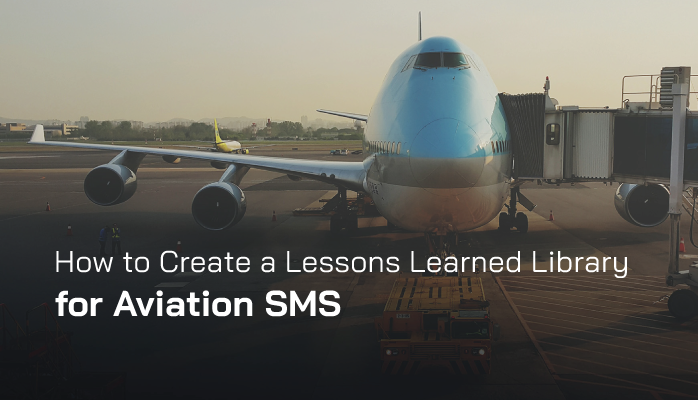Creating a Lessons Learned Library for Aviation SMS

In aviation, where safety is paramount, every incident, near-miss, or hazard offers a valuable opportunity to learn and improve. A lessons learned library is a structured, accessible repository that captures, organizes, and disseminates critical safety insights from past events.
For aviation safety managers and accountable executives, building such a library is a cornerstone of a proactive Safety Management System (SMS), aligning with International Civil Aviation Organization (ICAO) standards and fostering a culture of continuous improvement.
This guide provides a step-by-step approach to creating a lessons learned library that enhances safety performance, ensures regulatory compliance, and empowers your organization to prevent recurring incidents. Whether you manage an airline, airport, maintenance organization, or flight school, this evergreen article will equip you with the tools and strategies to turn safety data into actionable knowledge.
Why a Lessons Learned Library Matters in Aviation SMS
A lessons learned library is more than a database—it’s a dynamic tool that transforms raw safety data into wisdom. According to ICAO’s Safety Management Manual (Doc 9859), an effective SMS relies on Safety Assurance and Safety Promotion, both of which benefit from systematic knowledge sharing. A well-designed library:
- Prevents Repeat Incidents: By documenting root causes and corrective actions, it ensures past mistakes aren’t repeated.
- Enhances Compliance: Supports ICAO and regulatory requirements (e.g., FAA, EASA) by demonstrating a commitment to safety improvement.
- Promotes a Just Culture: Encourages voluntary reporting by showing employees that their insights drive change.
- Drives Efficiency: Reduces the time spent investigating similar incidents by providing ready access to proven solutions.
For accountable executives, a lessons learned library offers transparency into safety trends, enabling data-driven decisions. For safety managers, it streamlines incident analysis and training. Without one, organizations risk losing critical knowledge due to staff turnover, siloed data, or reactive safety practices—outcomes that can compromise safety and compliance.
Related Articles on Lessons Learned Library in Aviation SMS Context
- Why Lessons Learned Library Matters for Aviation Safety
- How Mistakes Improve Aviation SMS Processes - Lessons Learned Library
- Comprehensive Guide to Using a Lessons Learned Library in Aviation SMS
Key Components of an Effective Lessons Learned Library
Before diving into the creation process, understand the essential elements of a lessons learned library:
- Comprehensive Data Capture: Includes incident details, root causes, corrective actions, and outcomes.
- Accessibility: Easy to navigate for all stakeholders, from frontline crew to executives.
- Searchability: Allows users to find relevant lessons using keywords, categories, or filters.
- Security: Protects sensitive data with role-based access controls.
- Integration: Connects with SMS software and other systems for seamless data flow.
- Regular Updates: Ensures the library remains current with new insights and regulatory changes.
With these components in mind, let’s explore how to build a lessons learned library that meets your organization’s safety needs.
Step-by-Step Guide to Creating a Lessons Learned Library

Follow these actionable steps to develop a robust lessons learned library that supports aviation safety risk management.
Step 1: Define Objectives and Scope
Start by clarifying the purpose and scope of your lessons learned library. Align it with your SMS goals and ICAO’s four pillars (Safety Policy, Safety Risk Management, Safety Assurance, Safety Promotion). Key questions to address include:
- What types of events will be included? Incidents, near-misses, audits, hazard reports, or safety suggestions?
- Who is the audience? Pilots, maintenance crews, ground staff, safety managers, or executives?
- What outcomes do you seek? Reduced incidents, improved training, or enhanced compliance?
For example, an airline might focus on flight-related incidents and crew training, while an airport prioritizes ground handling and security hazards. Involve stakeholders—safety managers, quality assurance teams, and accountable executives—to ensure the library addresses all needs. Document these objectives in a clear policy to guide development.
SMS Pro automatically categorizes lessons learned and offers full text search capability for easy retrieval of related lessons learned.
Step 2: Establish a Standardized Data Collection Process
Consistency is critical for a usable lessons learned library. Develop a standardized template for capturing lessons, including:
- Event Description: Date, location, type (e.g., incident, near-miss), and a brief narrative.
- Root Cause Analysis: Use tools like the 5 Whys or Fishbone Diagram to identify underlying causes.
- Corrective Actions: Detail actions taken to mitigate risks.
- Outcomes: Document the effectiveness of actions and any residual risks.
- Metadata: Tags (e.g., “runway incursion,” “maintenance error”), categories (e.g., operational, human factors), and severity levels.
Leverage your SMS software (e.g., SMS Pro, ABC) to collect data via incident reporting forms. Encourage anonymous reporting to align with just culture principles, as seen in platforms like SMS Pro, which boost safety reporting rates by 50%+. Train staff to submit detailed, accurate reports to ensure data quality.
Step 3: Choose the Right Technology Platform
The library’s backbone is its technology platform. Options range from simple databases to integrated SMS modules. Key considerations include:
- Cloud-Based Solutions: Platforms like SMS Pro and ABC offer secure, scalable storage with mobile access.
- Search Functionality: Advanced search tools (e.g., keyword, filter-based) make lessons easy to find.
- Integration: Ensure compatibility with SMS software, ECCAIRS, or operational systems.
- User Interface: Intuitive dashboards, like those in SMS Pro, enhance usability and direct uses to "topics of interest."
For small operators (20–50 employees), a basic cloud database with tagging capabilities may suffice, costing $100–$300/month. Larger organizations need enterprise solutions with analytics and API support. Avoid generic tools like spreadsheets, which lack scalability and security for organizations with over 40 employees.
Related Aviation SMS Database Articles
- What Is an Aviation Safety Database
- 5 Most Important Things to Know Before Buying Aviation SMS Database
- How to Choose the Best Aviation Safety Database Software
Step 4: Design the Library Structure
Organize the library for accessibility and relevance. Use a hierarchical structure with:
- Categories: Group lessons by type (e.g., operational, maintenance, human factors).
- Tags: Enable cross-referencing (e.g., “fatigue,” “communication error”).
- Filters: Allow users to sort by date, severity, or department.
- Summaries: Provide brief overviews for quick reference, with links to detailed reports.
For example, a library entry for a runway incursion might include:
- Summary: “Near-miss due to miscommunication between ATC and crew.”
- Category: Operational
- Tags: Runway safety, human factors, communication
- Details: Root cause (fatigue), corrective action (revised training), outcome (no recurrence in 12 months).
Test the structure with end-users to ensure it’s intuitive. Platforms like SMS Pro offer customizable taxonomies, making it easy to adapt the library to your needs.
Step 5: Implement Data Security and Access Controls
Aviation safety data is sensitive, often containing personal or proprietary information. Protect the library with:
- Role-Based Access: Limit access based on job roles (e.g., executives see high-level trends, crews access training-focused lessons).
- Encryption: Secure data in transit and at rest, as provided by cloud platforms like SMS Pro and ABC.
- Audit Trails: Track who accesses or edits entries to maintain accountability.
Compliance with GDPR, FAA, or EASA data protection standards is essential. Work with your IT team to configure permissions and ensure the platform meets regulatory requirements.
Step 6: Populate the Library With Historical Data
Seed the library with existing safety data from incident reports, audits, and investigations. Prioritize high-impact events, such as serious incidents or recurring hazards. For each entry:
- Conduct a Retrospective Analysis: Use tools like Bowtie Analysis to revisit root causes and outcomes.
- Standardize Entries: Convert old reports into the new template for consistency.
- Validate Data: Ensure accuracy by cross-checking with safety managers or investigators.
For example, an airline might add a 2023 engine failure incident, noting the cause (maintenance oversight), action (revised checklists), and outcome (50% reduction in similar issues). This process can take weeks for large organizations, so allocate sufficient resources.
Step 7: Promote a Culture of Contribution

A lessons learned library thrives on continuous input. Encourage employees to contribute by:
- Simplifying Reporting: Use mobile-friendly SMS software for real-time submissions.
- Recognizing Contributions: Highlight how reports lead to safety improvements.
- Training Staff: Educate teams on the library’s value and how to use it.
Safety Promotion, one of ICAO’s SMS pillars, emphasizes communication. Share success stories, like how a crew’s hazard report prevented a collision, to boost engagement. Platforms like SMS Pro support public issue reporting, ensuring all stakeholders can contribute without cost barriers.
Step 8: Integrate With Training and Safety Assurance
Link the library to your training and Safety Assurance processes. Use lessons to:
- Update Training Programs: Incorporate real-world scenarios into crew or maintenance training.
- Monitor Trends: Track recurring issues to inform risk assessments.
- Support Audits: Provide evidence of lessons applied during regulatory audits and inspections.
For instance, SMS Pro's analytics can identify trends (e.g., frequent taxiway errors), prompting automated alerts and targeted training. This integration strengthens your SMS and demonstrates compliance to regulators.
Related Aviation SMS Audit Articles
- Real Difference Between an Aviation Safety Audit vs. Inspection
- Audit Checklist: 10 Things to Prepare for Aviation SMS Audits
- How to Conduct Internal SMS Audits in Aviation Industry
Step 9: Maintain and Update the Library
A static library quickly becomes obsolete. Establish a maintenance plan:
- Regular Reviews: Quarterly audits to verify data accuracy and relevance.
- Update Entries: Reflect new outcomes or regulatory changes.
- Archive Old Data: Retain historical lessons for reference but prioritize recent insights.
Assign a safety manager to oversee updates and ensure the library aligns with evolving ICAO standards. Use analytics to identify gaps, such as underreported categories, and address them proactively.
Step 10: Measure Impact and Refine
Evaluate the library’s effectiveness using key performance indicators (KPIs):
- Reporting Rates: Increased submissions indicate a stronger safety culture.
- Incident Reduction: Fewer repeat incidents show lessons are applied.
- User Engagement: High access rates suggest the library is valued.
For example, an airport using SMS Pro's platform saw a 40% drop in ground handling incidents after implementing a lessons learned library. Solicit user feedback to refine the library’s structure, usability, or content. Continuously improve based on data and stakeholder input.
Common Pitfalls to Avoid
- Siloed Data: Ensure the library integrates with SMS software to avoid fragmented information.
- Complex Interfaces: A cluttered design discourages use; prioritize simplicity.
- Neglecting Promotion: Without employee buy-in, the library will be underutilized.
- Ignoring Security: Data breaches can erode trust and violate regulations.
- Static Content: Failing to update the library risks irrelevance.
Conclusion
A lessons learned library is a powerful tool for aviation safety managers and accountable executives, turning safety data into a catalyst for improvement.
By following these steps—defining objectives, standardizing data, choosing the right platform, and fostering a culture of contribution—you can create a library that mitigates risks, ensures compliance, and strengthens your SMS. Leverage technology like SMS Pro or ABC to streamline the process and maximize impact.
Investing in a lessons learned library is an investment in safer skies. Start today by assessing your current safety data and taking the first step toward a proactive, knowledge-driven safety culture.
Ready to build your lessons learned library? Explore SMS platforms and begin capturing your organization’s safety wisdom now.






